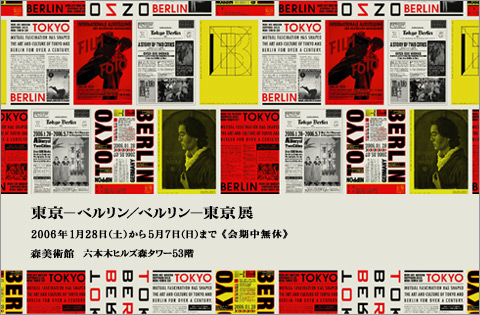Tokyo-Berlin / Berlin-Tokyo
dal 27/1/2006 al 6/5/2006
Segnalato da
27/1/2006
Tokyo-Berlin / Berlin-Tokyo
Mori Art Museum, Tokyo
The show traces the cultural links between these two great world capitals from the end of the nineteenth century until the present day. Cultural contact between the two capitals at these times was not limited to art, but included numerous fascinating exchanges in such fields as architecture, photography, theatre and design. This exhibit reflects the varied interaction and traces their history in a total of some 500 works divided into 11 sections.

500 works
Tokyo-Berlin / Berlin-Tokyo traces the fascinating cultural links between these two great world capitals from the end of the nineteenth century until the present day. Through two world wars, a devastating earthquake, high-speed economic growth, failed ideologies, and economic recessions, both cities experienced similar periods of ruin and rebirth. Cultural contact between the two capitals at these times was not limited to art, but included numerous fascinating exchanges in such fields as architecture, photography, theatre and design. This exhibit reflects the varied interaction and traces their history in a total of some 500 works divided into 11 sections.
The first half of the exhibition showcases individual artists and exhibitions that influenced Tokyo's artistic community in the early twentieth century, including: Berlin architects Hermann Ende and Wilhelm Bockmann, who designed the original Ministry of Justice building (1887) in the Neo-Baroque style; the Der Sturm Gallery exhibition (1914), which Yamada Kosaku, a composer and others brought back to Japan from Berlin; Murayama Tomoyoshi, who created a sensation when he helped found the MAVO group (1923) after absorbing such influences as Russian avant-garde, Italian futurism, and Dadaism during a stay in Europe; and the film and photography exhibition FIFO, which had immense impact on the New Photography movement when it came to Japan in 1931. Also included are Yamawaki Iwao and Mizutani Takehiko, who studied at the Bauhaus, and Bruno Taut, one of the most important architects in Berlin who spent three years in Japan in flight from the Nazis in the 1930s. This part of the exhibition highlights these individuals as it explores the relationship between Bauhaus and Japanese architecture and design.
The second half of the exhibition focuses more on the parallel relationships between the two cities and their artistic movements. Works in this section start with the late 1930s, when both nations were on the brink of World War II and continues through war and its accompanying defeat and the rebirth and reconstruction in the 1950s. This is followed by the 1960s, when the New York-centered Fluxus movement united avant-garde movements in Tokyo and Berlin, that then grew and flowered together. Finally, the focus of the exhibition shifts to Germany at the end of the Cold War. After the Berlin Wall was torn down the city once again became the capital of a reunified Germany. This revitalized Berlin has grown into a vibrant city capable of sustaining its both history and traditions to produce fresh and dynamic contemporary art.
Tokyo - Berlin / Berlin - Tokyo is one of the biggest events of the Germany in Japan 2005/2006 festival, and will also tour to Germnay, where it will be displayed at Berlin's Neue Nationalgalerie from June 2006.
Sections
* BERLIN-TOKYO 1880-1914 Exoticism and Modernity
* DER STURM IN TOKYO 1914 The Impact of the Avant-garde
* TOKYO-BERLIN 1912-1923 New Visions in Art and Architecture
* CULTURES IN CONFLICT 1918-1925 Berlin Dada, Tokyo MAVO and the influence of the Russian
Revolution
* MODERN GIRLS, MODERN BOYS Moga and Mobo in 1920s Tokyo and Berlin
* FIFO (FILM UND FOTO) 1929-1931 New Approaches in Photography
* BAUHAUS AND BRUNO TAUT Design and Architecture in the 1930s
* THE DARK YEARS 1931-1945 Dictatorship, Resistance and War
* RECONSTRUCTION 1945-1950s The Aftermath of War
* FLUXUS, POP ART AND NEW EXPRESSIONISM IN THE 1960s
* BERLIN NOW, Contemporary Art After the Wall
Organizers: Mori Art Museum; Staatliche Museen zu Berlin, Neue Nationalgalerie; Asahi Shimbun In Collaboration with the Embassy of The Federal Republic of Germany in Japan and the Goethe-Institut Tokyo.
Corporate Sponsors: ThyssenKrupp Elevator, adidas Japan K.K., Kajima Corporation, Matsushita Electric Works, Ltd., SieMatic.
Supported by: Tokyo Broadcasting System, Inc., Toei Company.
Additional support by: Japan Airlines, Color Kinetics Japan Inc., Champagne Nicolas Feuillatte.
Mori Art Museum
Roppongi Hills - Mori Tower 53F - Tokio
Hours: Every day except Tuesdays: 10-22. Tuesdays: 10-17. Admission until 30 minutes before closing.



